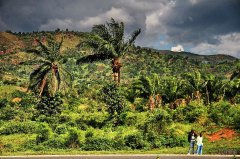Development of San Cristobal Coffee Fine Coffee beans
Laguna's population and urbanization developed rapidly in the 20th century: 50,000 in 1965 and nearly 120000 in 1995. The rapid development has brought some negative effects to the city, especially the "survey plan" in the 1960s, which has caused some old buildings to be destroyed and the new buildings out of harmony with the whole historic city. this problem mainly arises in Ella Dorres and Carrera Street.
Gunnar has won many honors in history. In 1510, Queen Donna Juana awarded Laguna City Shield. In 1531, Carlos V named the city "the largest and best city in Canary" and added it as "the City of nobles" in 1534. So far, Laguna has won the titles of "Noble City", "City of loyalty", "Historic City", "St. Cristobal City of Laguna" and so on. Laguna has about 3000 residents. Most of the public buildings and facilities were completed in the following decade, such as water piping systems, windmills, slaughterhouses and so on. At the same time, religious sites have also been built, large and small churches, monasteries all over every street, the years have not changed. Since the 17th century, the city has had an obvious period of stagnation, both in terms of construction and population. Historians believe that this is the result of the dispersion of residents, but this is not always the case. Statistics show that the population here increased from 7220 in 1561 to 9672 in 1805. By analyzing the map of 1831 and comparing it with the map of 1588, we can also draw the conclusion of stagnation.
Laguna culture and art once flourished in the 18th century. Many writers and artists of aristocratic origin often get together to talk about art and politics. The city has become "the model of urban social life and the center of the trend of culture and art". In the nineteenth century, Laguna was at a low ebb again due to the rise of Santa Cruz, another city on the island. However, even so, some cultural institutions, such as the University of San Fernando and the Diocese, have injected new life into the centuries-old city. In July 1496, Alonso. Fernandez. Druger conquered the last resistance of the Guanche (Canary natives) at Riareh, conquered Tenerife and turned it into the royal territory of Castilla. After Druger's victory, he led his team to Aguelle and was stationed there. Because Aguelle is not only the main road connecting the two sides of the island, but also far from the coast, it can be protected from pirates. In addition, the climate and soil here are more conducive to the development of grain cultivation and animal husbandry, and there are more freshwater resources. At first, they built some humble houses and a chapel dedicated to Notre Dame. These buildings lacked unified planning, were arbitrary and scattered, and the materials were rough and undurable. (such as adobe, wood, straw, etc.) it was only later that the islanders' meeting decided to adopt durable building materials. This is the so-called "high city" of St. Cristobal.
The change in the construction layout of San Cristobal took place in Alonso. Fernandez. Druger made a decision to move. It is rumored that the decision was taken because his son was killed in a fight. However, history has proved that this is not the case, so it may be Druger's personal will to plan and build according to the plane geometry and square plan popular in Europe at that time, so there is a later "low city". Drucker's will was enshrined in the resolution of the Islanders meeting on April 24, 1500, requiring people to settle in "low cities" and forbidding any buying, selling, building and building in "high cities". The island department has also taken many relevant measures to make the residents of San Cristobal use good materials when building houses, keep the streets wide and clean, buildings neat and coordinated, and so on. In short, it is to build a small residential area into a real city of revival of literature and art.

Important Notice :
前街咖啡 FrontStreet Coffee has moved to new addredd:
FrontStreet Coffee Address: 315,Donghua East Road,GuangZhou
Tel:020 38364473
- Prev

Brewing skills of hand-brewing coffee how to control the time of hand-brewing coffee
The thickness of coffee powder is about the thickness of granulated sugar, and the thickness is more uniform. Hand-made coffee about bean grinder: it is suggested that friends who like drinking freshly ground coffee should invest in a reliable bean grinder, whether electric or manual, the quality of the product is much better than that of buying coffee powder, and the price for household use is not very high. About hand pots: there are many kinds of hand pots, different brands, no
- Next

Ethiopia Sidamo Sidamo Guji Shakiso coffee bean agent
The coffee flavor of Sidamo is very diverse, because of the different soil composition, regional microclimate and countless native coffee varieties, the coffee produced in each urban area has obvious differences and characteristics. Sidamo producing area (Sidama) is located in the south of Ethiopia. The industry here is mainly agricultural, and the coffee growing area is located around the Great Rift Valley (Great Rift Valley) of East Africa.
Related
- Does Rose Summer choose Blue, Green or Red? Detailed explanation of Rose Summer Coffee plots and Classification in Panamanian Jade Manor
- What is the difference between the origin, producing area, processing plant, cooperative and manor of coffee beans?
- How fine does the espresso powder fit? how to grind the espresso?
- Sca coffee roasting degree color card coffee roasting degree 8 roasting color values what do you mean?
- The practice of lattes: how to make lattes at home
- Introduction to Indonesian Fine Coffee beans-- Java Coffee producing area of Indonesian Arabica Coffee
- How much will the flavor of light and medium roasted rose summer be expressed? What baking level is rose summer suitable for?
- Introduction to the characteristics of washing, sun-drying or wet-planing coffee commonly used in Mantenin, Indonesia
- Price characteristics of Arabica Coffee Bean Starbucks introduction to Manning Coffee Bean Taste producing area Variety Manor
- What is the authentic Yega flavor? What are the flavor characteristics of the really excellent Yejasuffi coffee beans?

